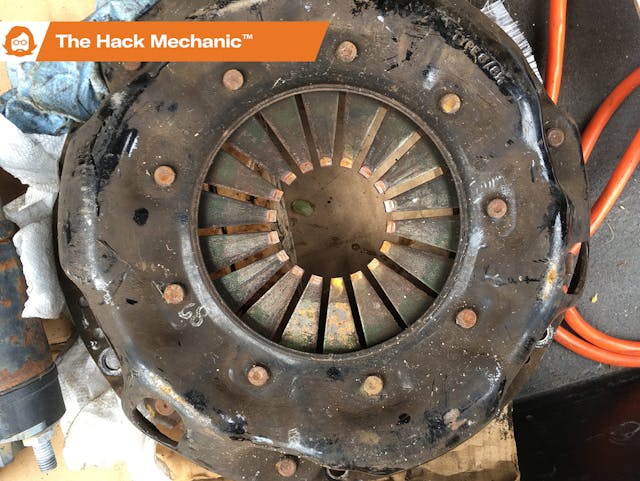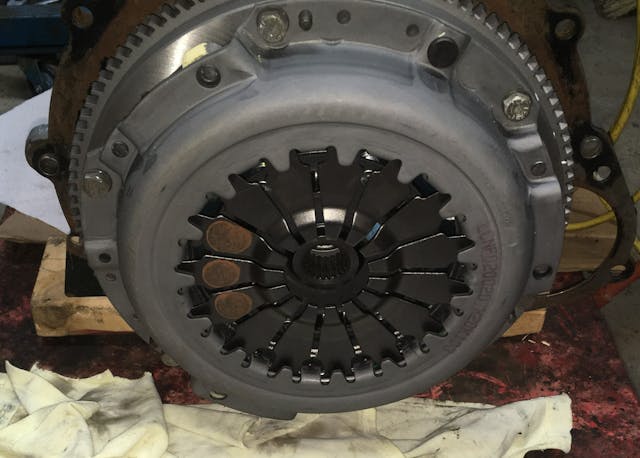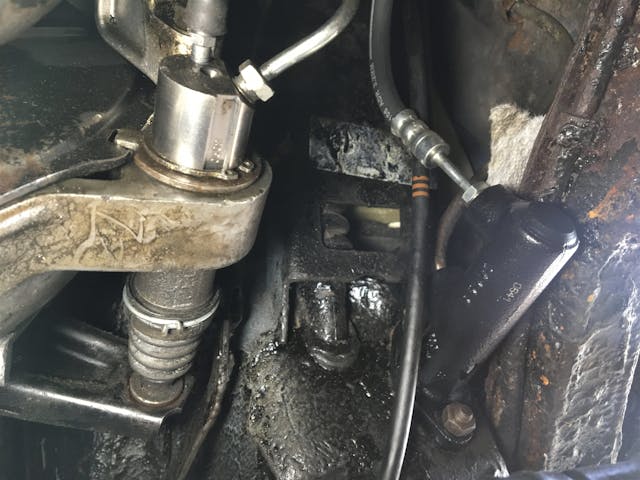Clutch performance and the advantage of hydraulics

A few weeks ago, when writing about helping a woman sell her husband’s BMW 2002tii, I mentioned replacing the clutch hydraulics because the brake fluid reservoir, which also feeds the clutch, was half-drained, and that halfway point is exactly where the pipe to the clutch master cylinder is. When I examined the clutch slave cylinder, it was clearly leaking. The area under the master cylinder was moist as well.
It was the fifth clutch hydraulic replacement I’ve done the past few years. Clutch hydraulic failure used to be relatively uncommon. Perhaps you’d replace a slave cylinder once in the lifetime of a daily driver—the clutch master cylinder, never. But now, as these early 1970s cars are 50 years old, problems with clutch hydraulics have become so common that I added them onto my list of “The Big Seven” things likely to strand a vintage car on a road trip.

Replacing the 2002tii’s clutch hydraulics while it was parked a few feet from my Lotus Europa—which has a cable clutch instead of a hydraulic one—made me think about the clutch family tree.
My first exposure to a clutch happened in an unusual way. In the late 1960s, I was still a kid living on Long Island. Sting Ray-style bicycles were all the rage, and some of the tough kids in junior high school were motorizing them by taking a lawnmower engine, mounting it on a tilting platform in the middle of the bike’s frame, and attaching a wooden dowel to the output shaft. By tilting the platform and letting the dowel rest against the rear tire, they could take the bike from stationary to moving. It was, of course, incredibly dangerous—the now-motorized bikes still had just the rear coaster brake to slow them—but I still recall seeing that spinning dowel, a kid tilting the platform, the sight and the smell of the little puff of smoke when the wood bit into the rubber, and the bike taking off. It was another eight years before I became a car-crazed teenager, but I knew what a clutch was. I might not yet have been able to name the individual parts, but the concept of needing to couple and uncouple the spinning thing that’s producing the power from the wheels was indelibly etched on my brain. Of course, after the clutch fork and throwout bearing sleeve on my Triumph GT6 both broke, I could name all the pieces very well, interspersed with a good deal of blue language.
Manual automotive clutches are, of course, a bit more sophisticated than a spinning wooden dowel mashed against the tire. Nearly all of them work by having a clutch plate with a machined-flat surface and a clutch disc made with sacrificial friction material like what’s on brake pads. The clutch plate is the face of an assembly that’s bolted to the flywheel. The assembly also contains a set of sprung “fingers” that moves the plate backward when the fingers are depressed. The clutch disc, which has splines in the middle through which the transmission input shaft passes, is sandwiched between the machined surfaces of the clutch plate and the flywheel. If nothing is pressing against the clutch fingers to release the pressure of the plate against the disc, the rotary motion of the spinning flywheel is transferred to the clutch disc, which in turn spins the transmission input shaft, thus spinning whatever gear is selected to transfer power to the rear wheels. Note that this means that the default state of the clutch is “engaged.” Disengaging it requires separating the discs, which in turn requires the clutch fingers to be pressed in.


The disengagement of the clutch—the separation of the plate from the disc—occurs when the clutch release mechanism pushes against the plate’s fingers. This is almost always accomplished with a throw-out bearing, a sleeve, and a release lever, also called a clutch fork. The throw-out bearing is like a donut with a ball bearing race assembly with a flat face on one side. The bearing allows the flat side to be pressed against the spinning clutch fingers. The sleeve is a cylinder that the transmission input shaft passes through and the throwout bearing slides on. The lever is attached to the sides of the throwout bearing. When the lever is pushed, it slides the throwout bearing along the sleeve until the flat bearing face contacts the spinning clutch fingers. The pressure from the lever causes the flat bearing surface to push against the fingers on the plate. This draws the plate backward, relieving the pressure on the disc, thus disengaging the clutch.

But I’ve left out one key detail: What is between the clutch pedal and the release lever that causes the action of your left foot to move the lever? Well, that is the whole point of this article.
For over 40 years, most automobile clutches have been hydraulic. Depressing the clutch pedal moves a rod which presses against a piston inside the clutch master cylinder. This creates pressure in the clutch hydraulic fluid, which is sent through a connecting hose to the clutch slave cylinder. In the slave, the reverse happens—the pressure in the fluid moves a piston inside the slave, which moves a rod that’s pressing against the clutch release lever. It’s just like the car’s brakes, only instead of squeezing brake pads against rotors, it’s pushing a lever that separates the clutch plates.

But before there were hydraulic clutch linkages, some form of direct mechanical linkage was employed. Some cars used a set of ball-in-socket linkage rods somewhere in size between an accelerator linkage and a set of tie rods and steering arms. Stepping on the clutch pedal typically pulled a rod, which caused another rod to rotate, which pushed a third rod that was connected to the clutch release lever. This sort of arrangement made sense on front-engine cars where the distance from the pedal bucket to the transmission was relatively short.

Just to pick one American car as an example, I believe that C1 through C3 Corvettes all used mechanical clutch linkages that look fairly similar to the one from the early BMW 2002, and that it wasn’t until the C4 Corvette in 1984 that the clutches went hydraulic.

The main advantage of rod-based mechanical clutch linkages is reliability. Yes, the ball-and-socket or Heim joint linkages wear, but they’ll generally give you a lot of warning before they fail completely, not unlike a sloppy gearshift lever. The downside is that, as the clutch wears down and the linkage components develop play, the system required adjustment.
The other common type of mechanical clutch linkage is a cable. Cables made perfect sense in rear-engine cars, where the length of a rod-based linkage would likely introduce play as well as have clearance problems. Air-cooled Volkswagens famously had cable clutches, as did Porsche 911s up through 1988. Clutch cables were simple, inexpensive, and could be changed fairly quickly, which was a good thing because they inevitably broke, and did so at the worst possible time.
When my wife and I owned VW buses, we always had a spare clutch cable with us, but that didn’t prevent me from having to occasionally start the car in gear and run red lights in order to get home. While mastering the ability to start a car with no clutch in gear, let it cough and lurch its way forward as if you did it by accident, and feeding just enough gas to get it running, is a life-skill that every car nut should have (and for mad extra credit, you can try to teach yourself how to shift without the clutch by matching engine and transmission RPMs), it’s not something that makes for a relaxing outing. It once happened to us when we were out for dinner in downtown Austin, Texas, and we had to wait for the two cars that were parallel-parked in front of us to move before I felt like I had sufficient running room for the in-gear start.

Sudden failure isn’t the only downside of cable clutches. Because the cable stretches, periodic adjustment is necessary. And it wasn’t only rear-engine cars that had cable clutches. Many cars had them, and for a surprisingly long time—Mustangs had cable clutches all the way up through 2004. I don’t think any new car sold in the United States still has a cable clutch, but some econoboxes sold in other markets reportedly still have them, and they’re still common on motorcycles.
The big advantage of hydraulic linkages is that they’re self-adjusting—the clutch linkage itself doesn’t require adjustment as the clutch wears. And they give a very uniform pedal feel, even if it’s perhaps not as visceral as a mechanical clutch.
As I think about it, the trade-offs between cable and hydraulic clutches are somewhat analogous to the argument about points versus electronic triggering. Like points, cable clutches are not terribly difficult to replace by the side of the road, if necessary, but it sometimes is necessary, so you carry a spare. Like electronic triggering modules, hydraulic clutches eliminate the need for adjustment. Roadside replacement of clutch hydraulics, though, isn’t something I’d want to do. When the clutch master cylinder in the BMW 2002tii that I wrote the book about (Ran When Parked) died at the gas station—which was literally at the entrance ramp to the highway as I was about to begin the 1000-mile trip home—I cough-started it and nursed my way back to a friend’s pole barn where I had a floor jack, stands, and a cement floor.
There are enthusiasts who feel that a mechanical clutch linkage, particularly a non-cable rod-based one, gives you better clutch feel in the same way that non-power steering gives you better road feel. But in general, despite my railing against the increasingly common failure of 50-year-old master and slave cylinders, I think the advantages of hydraulic clutches outweigh the downsides. And I’m not the only one—If you read up on old cars with rod or cable-based mechanical clutches, you find kits to convert them to a hydraulic clutch. I don’t think I’ve ever seen a cable-based retrofit kit to de-hydraulic your clutch linkage.
So be at peace with your hydraulic clutch linkage. Just replace it at the first sign of leakage or trouble.
***
Rob Siegel’s latest book, The Best of the Hack MechanicTM: 35 years of hacks, kluges, and assorted automotive mayhem, is available on Amazon. His other seven books are available here, or you can order personally inscribed copies through his website, www.robsiegel.com.


’72 Plymouth had a z-bar (what we Mopar guys called it) arrangement not unlike the C2 pushrod linkage depicted; one ball stud on the frame rail for the left end of the z-bar (a torque bar) and another ball stud screwed into the bellhousing. Worked pretty well, as long as the left motor mount wasn’t broken. Assist spring for the 3-finger clutch discs was located under the dash on the pedal, and was usually a bear to remove or reinstall.
Recently had the pleasure of having the clutch master cylinder fail on a DD Acura while 30 miles from home. 5 traffic lights to get onto the freeway, 6 traffic lights and one stop sign to negotiate after leaving the highway. Traffic on I-5 didn’t usually get bad until 2pm and it was noon, SO off we go. Got lucky getting onto the freeway, as even with the steep hill from the commercial district, I was able to adjust the speed in 2nd gear to avoid stopping for traffic and make most of the lights (one might have been red). Getting off the freeway entailed the aforementioned gear shifting technique sans clutch, and timing the lights accurately. The stop sign was only 1/2 mile from home, so made the first stop and restarted the engine in gear from the stop to drive home in 1st.
Getting the car into the garage the next day was actually the trickiest part. Had to back in, as nose-in didn’t allow room to open the door sufficiently to access under the dash to replace the master cylinder. First had to wait for neighbor to go to work, as I needed his downsloping driveway to allow starting the car in reverse (reverse is higher geared than 1st). Also had to warm up the car enough for the idle to come down from the high IAC idle. Got the car up the neighbor’s driveway and killed it without hitting anything. Started the car in reverse, idled the car down the neighbor’s driveway, up my driveway, into the garage and killed it slightly off center and a foot short of where I wanted it. Then went inside the house for a cold drink of water to get my heart rate down. I hope I never have to do that again. Lesson learned. Bled the brakes every few years – forgot the clutch (the reservoir is small and the slave can’t even be seen from below – and that’s my excuse). Dollies later helped get the car ideally located so the wife can park her car inside at night…